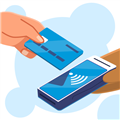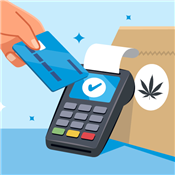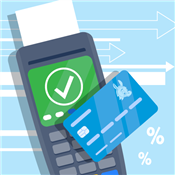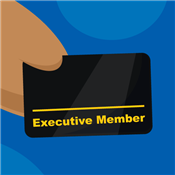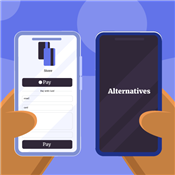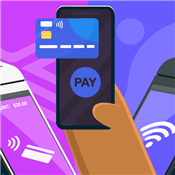Credit Card Reader for Android
Boost your business with the best credit card readers for Android devices - perfect for small businesses. Choose from the top picks in this article.
These providers offer card readers for your Android device:
- Square as best overall
- Payanywhere for multi-branch stores
- Intuit GoPayment for bookkeeping
- Shopify for eCommerce sellers
- PayPal POS for easy access to funds
- Clover Go for freelancers
- SumUp for small retail stores
Accepting swipe, chip, and tap payments on your Android device is simpler than you might think. All it takes is an internet connection, a compatible card reader, and a payment processing app.
With many apps and readers available today, you have plenty of options to choose from. Check out the selection below to find the right fit for your needs.
Best Credit Card Readers for Android
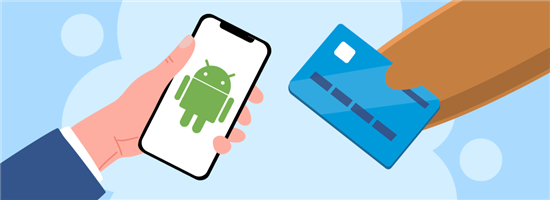 |
You can use your Android device with a card reader through the help of point-of-sale systems. Your chosen payment processor may offer a POS app so you could take payments on your mobile device.
More about how it works on each of the options below.
Square as Best Overall
| Magstripe reader | Free (additional readers $10 each)[1] |
|---|---|
| Chip or contactless reader | $59[1] |
| Swipe, chip, or tap payments | 2.6% + $0.15 per transaction |
| Keyed-in payments | 3.5% + $0.15 per transaction |
| Monthly fee | Starts at $0/mo |
Square offers a free card reader compatible with Android. You only need to choose the card reader with the headphone jack.
The card reader works with the powerful and free Square Point of Sale app that comes with features like customer management, inventory management, robust reporting, automated tipping, etc.
Why We Like It:
You won't need to charge Square's card reader, which makes it convenient to use. You don't need to worry about the battery life or having extra devices for backup.
The card reader also takes payments in offline mode, so a fluctuating WiFi connection is not a problem.[2] This could benefit mobile businesses who move from one location to another.
Additionally, Square offers a contactless and chip card reader which lets you take Apple Pay, Google Pay, and chip card payments. It can be a good addition to the free card reader since the free reader is limited to swipe payments only.
Pros:
- Free plan available[3]
- Easy to set up and use
- Accept most major credit, debit, and gift cards
- Instant access to a breakdown of sales on your dashboard
- Set up a free online store (some competitors charge for this)
Cons:
- Merchants often experience frozen funds
- Not for high-risk businesses
- Lackluster customer support
Square Reader: Free Mobile Credit Card Reader
- Pay 2.6% + 15¢ Per Swipe for Visa, Mastercard, Discover, and American Express
- Accept Credit Cards Anywhere
- Fast Setup, No Commitments
Payanywhere for Multi-Branch Stores
| Card reader | 3-in-1 card reader: $59.95; Terminal and POS available for purchase[4] |
|---|---|
| Swipe rate | 2.69% per transaction |
| Keyed-in rate | 3.49% + 19¢ per transaction |
| Monthly fee | No monthly fees; $3.99/mo inactivity fee for merchants with no transaction for 12 months |
Payanywhere offers a 3-in-1 card reader that lets you accept magstripe, chip cards, and contactless payments like Apple Pay and Samsung Pay. It connects through Bluetooth, hence you can easily use it with your Android device.
It also partners with Payanywhere's point-of-sale app for you to accept payments. Other POS features let you send invoices, manage employee data, manage inventory, access real-time updates, automate tipping, etc.
Why We Like It:
If you purchase multiple card readers, you can view the precise location of your sales from each of them through the POS app. It's ideal if you have food trucks or pop-up shops in different locations.
Also, just like Square, you can take offline payments with Payanywhere. That said, there's a default transaction limit of $100, and it's only applicable for swipe, EMV chip, and cash payments.[5]
You can test the POS app to see if it fits your needs. Just click "Test Drive" on the login screen after you download the app. You won't need to create an account.
Pros:
- Accept swipe, chip, contactless, or keyed-in payments
- Send text or email receipts instantly
- No monthly, subscription, or ongoing fees; only pay for processed payments
- 24/7 customer service
Cons:
- Infrequent users may incur a $3.99 per month fee[6]
- Accounts may be canceled or funds frozen without warning
- Third-party integrations can be complicated
While not required, chip or tap credit card readers decrease the risk of stolen information. They immediately encrypt information rather than broadcasting it like swipe readers do. Most credit card processing companies offer full PCI compliance. But there's still a risk of fraudulent activity with swiped cards.
Intuit GoPayment for Bookkeeping
| Card reader | $49 card reader[7] |
|---|---|
| Card payments | 2.5% per transaction[8] |
| Digital wallet payments | 2.5% per transaction[8] |
| Keyed-in payments | 3.5% per transaction |
| Monthly fee | Starts at $0/mo |
Intuit GoPayment offers a card reader that lets you accept card and digital wallet payments. It connects to your Android device through Bluetooth, hence it needs to charge (unlike Square's card reader plugged to your phone).
But the battery life can last you a week, depending on your usage. You can purchase the power stand with the card reader ($79) or separately ($39) if you plan to place it on your countertop.[7]
Additionally, the point-of-sale app lets you accept keyed-in payments and send invoices to customers. Other features let you manage your employees, save customer info, and accept tips.
Why We Like It:
Transferring data from your POS to your bookkeeping system leaves room for errors. Intuit GoPayment can help you avoid these errors. If you are a current QuickBooks user, you can integrate bookkeeping with the mobile POS to get the best of both worlds.
The card reader partners with the GoPayment app. New merchants may also qualify for a free card reader.[9]
Pros:
- Simple card reader display
- Power stand lengthens the card reader's battery life
- Keeps card info on file handy for returning customers
- Scan the items for purchase to easily spot them in your inventory
- Instant payments available for a 1.75% fee
Cons:
- Requires a QuickBooks Online account or a merchant account
- You may need to be approved for an account[7]
- Watch out for miscellaneous fees[7]
Shopify for eCommerce Sellers
| Shopify Tap & Chip Reader | Card reader: $49; Terminal and POS available for purchase[10] |
|---|---|
| Dock for the card reader | $40 |
| Swipe rate | 2.4% to 2.6% (+ $0.10) per transaction |
| Monthly fee | starts at $39/mo ($29/mo if paid annually) |
Shopify offers a card reader that connects wirelessly to your Android device. You can accept chip and contactless payments with it. There's also a dock available ($40) for when you place your reader on the countertop.[11]
The card reader is fully integrated with the Shopify POS. Some point-of-sale features include in-store pickup, low-stock alerts, product QR codes, local deliveries, etc.
Why We Like It:
If you sell online and in-person, you need a system that syncs all information. The Shopify POS app, together with its card reader, can do just that.
The card reader also accepts major payment methods such as Mastercard, Visa, Discover, AMEX, Apple Pay, and Google Pay. Just note that you need Shopify Payments to use the card reader.
Pros:
- Try Shopify for free for 3 days; pay $1 for the first month[12]
- Free shipping
- Free 30-day returns
- Track orders and payments easily with the POS
Cons:
- Requires Shopify Payments
- You can't take offline payments[13]
PayPal POS for Easy Access to Funds
| Card reader | $29 for the first reader; additional card readers cost $79 each[14] |
|---|---|
| Swipe rate | 2.29% + $0.09 |
| Keyed-in payments | 3.49% + $0.09 (through PayPal POS) 3.39% + $0.29 (through the virtual terminal) |
PayPal offers PayPal POS—a card reader you can use with your Android device. It works with the free PayPal POS app, which also lets you accept contactless payments from your customers.
PayPal POS features include managing products, tracking sales by employee, product, and period, managing roles and permissions, sending and receiving payments from invoices, and more.
PayPal Point of Sale system accepts major debit and credit card payments. Specifically, you can accept Mastercard, Visa, AMEX, Discover, JCB, China Union Pay, Maestro, V Pay, and Visa Electron.[14]
Why We Like It:
PayPal is a trusted payment processor that can benefit your business and earn your customers' trust. What's more, after customers make a purchase, you can access your funds in your PayPal account within minutes.
This can benefit your cash flow as you won't need to wait for batches or settlements. You can also deposit the money into your bank account, but this can take a few business days.
Pros:
- No cancellation fees
- Only pay when you process payments
- Pay one fee for any type of credit card
- No inactivity fees or monthly minimum sales requirements
- Get help from a live customer service agent
Cons:
- Limited POS features
- No offline sales feature
- May encounter account holds and freezes
PayPal card reader needs charging. It comes with a USB charging cable, but you can also purchase a charging dock for $29. The battery can last up to 8 hours or about 100 transactions. Keep a backup card reader ready for longer shifts.
Clover Go for Freelancers
| Card reader | Card reader: $199; Terminal and POS available for purchase |
|---|---|
| Swipe rate | 2.3% to 2.6% (+$0.10) per transaction |
| Keyed-in rate | 3.5% + $0.10 per transaction |
| Monthly fee | Starts at $0/mo |
Clover offers Clover Go, which is a card reader that can work with your Android mobile or tablet. It works with either WiFi or cellular internet and comes with a Go Dock for when you have a countertop to place it on.
The Clover Go reader lets you accept chip, dip, and contactless payments like Apple Pay and Samsung Pay. It works with the Clover Go app, which you can download for free.
Why We Like It:
Clover Go may be more suitable for freelancers or small service businesses who only need the basics. With this POS, you can set discounts, set up one-touch tipping, process full or partial refunds, apply service charges, set up tax rates, etc.
That said, the most basic plan, which is the Payments plan, doesn't come with inventory management, customer management, and detailed reporting features. The feature to build an online store is also an add-on for the two available plans.
Pros:
- 24/7 support with all plans
- Free overnight shipping
- Comes with the Go Dock
- All cards, including AMEX, are charged the same rates
- Get funds within minutes of a sale for a 1.5% fee
Cons:
- Feature to build an online store is an add-on
- Lacks other essential features that are present with competitors
The Clover Go reader can last you up to 160 swipes or 130 contactless transactions in a single charge. If you typically get sales more than this in a shift, then it's best to have a backup or keep the card reader charged on the dock.
SumUp for Small Retail Stores
| Card readers | Card reader: $54 to $169; POS plan: starts at $99/mo |
|---|---|
| Swipe rate | 2.6% + $0.10 per transaction |
| Keyed-in rate | 3.5% + $0.15 per transaction |
| Monthly fee | No monthly fees for payment processing[15] |
Unlike its competitors, SumUp offers multiple card reader options, so you can choose what's best for your specific needs.
Here's an overview:
- SumUp Plus: connects via Bluetooth with your Android device; works with the free SumUp app
- SumUp Solo: standalone device with a touchscreen; 8-hour battery life
- SumUp Solo Printer Bundle: standalone device with a printer that also acts as a battery pack
All three options can be used with WiFi or mobile data. Some point-of-sale features you'll get include creating catalogs, tracking transactions, smart tipping, issuing refunds, etc.
You can accept major debit and credit card payments and contactless payment options. Specifically, you can accept Visa, Mastercard, AMEX, Discover, Diners Club, Google Pay, and Apple Pay.
Why We Like It:
SumUp Plus is the way to go if you're looking to use your Android device. It can process over 500 transactions with just one charge. That's 500 sales in a single shift!
Additionally, the SumUp app that works with it lets you not only accept payments in person but lets you issue invoices to your clients and send payment links.
Small retail businesses may benefit the most with it, considering there are no monthly fees. The SumUp Solo Printer Bundle may also work best for issuing receipts.
Pros:
- No contracts or monthly fees
- No hidden fees
- No monthly minimums
- 30-day money-back guarantee
- Entirely online setup process
Cons:
- Device takes 4-5 business days to arrive
- Registration requires approval
Other Credit Card Readers for Android
 |
| © CreditDonkey |
These readers didn't make our top list. But they offer features and benefits that may suit some businesses.
Stax
| B250 card reader[16] | Not disclosed online |
|---|---|
| Swipe rate | Interchange rate + $0.08 |
| Keyed-in rate | Interchange + $0.18 |
| Monthly fee | Starts at $99 per month |
If you want your own merchant account, consider Stax. A merchant account can decrease the risk of canceled accounts or frozen funds, unlike if you opt for payment processors like Square.
Stax offers an Android app that makes it easy to accept credit card and cash payments. Its membership pricing is also ideal for established businesses already with a history of credit card sales.
Some POS features you'll get include inventory management, invoicing, and reporting. Additionally, Stax's online dashboard provides a lot more features and is included in your subscription.
Pros:
- No cancellation fees
- Transparent membership-based pricing
- Track all payment types in the app, not just credit cards
- Customer service is available around-the-clock
- Accept all types of credit card payments including swipe, chip, or tap payments
Cons:
- Underwriting requirements are tougher
- The mPOS has limited features
- You must pay the monthly subscription fee even if you don't process any payments
Save Up to 40%
- Flat Monthly Subscription Price, Starting at $99
- 0% Markup on Direct-Cost Interchange
- 24/7 Support
SwipeSimple Connect
| SwipeSimple B250 card reader | $125[17] |
|---|---|
| SwipeSimple B200 card reader | $105[18] |
| Tap, dip, swipe, and contactless payments | 2.6% and 10¢ per transaction[19] |
SwipeSimple offers two card readers that can work with your Android device—SwipeSimple B250 and SwipeSimple B200.
Both connect with your device through Bluetooth and accept EMV and magnetic stripe cards. The difference is that you'll need SwipeSimple B250 if you want to accept contactless payments.
The card readers work with the SwipeSimple Mobile App, where you can access features like item catalog, tipping, invoicing, etc. SwipeSimple also supports offline mode so you can take payments even with a fluctuating internet connection.
Pros:
- 30-day return and refund policy
- No monthly fees with SwipeSimple Connect
- $49 card reader with a SwipeSimple Connect account
- Personalized training and setup
Cons:
- Battery life not specified
- USB chargers only (no docks)
- You may need to get approved for an account
You may often need card readers to accept credit card payments from your Android phone. This is safe as long as the processor that offers the card reader and point-of-sale app provides end-to-end encryption and is PCI-compliant.
However, some forms of payment are more secure than others. For example, taking EMV chip card payments is more secure than magstripe cards since EMV is a more updated technology.
What is a Credit Card Reader?
A credit card reader is a piece of hardware that lets you accept different modes of payment, like debit cards, credit cards, and contactless payments.
It typically functions with a point-of-sale (POS) app from a credit card processor, which you can often freely download on your mobile phone or tablet.
Many credit card readers and POS apps are available for both Android and iOS. These are great substitutes for smart terminals, which are often more expensive.
That said, not all credit card readers accept all payment types. Some card readers may be limited to EMV chip, magnetic stripe, or contactless payments only.
You can take credit card payments through your Android devices with the use of card readers. Choose from wireless options or those you connect through a headphone jack. These often work with POS apps to process transactions.
How Does a Credit Card Reader Work?
A credit card reader is one of the available POS equipment you can use to accept and process card payments.
It may be one or all of the following:
- Magstripe reader: accepts swipe payments from magnetic stripe cards; the stripe on the card contains your customer's information and is read by the card reader
- EMV chip reader: accepts dip payments from chip cards (also known as EMV cards); the microchip on the card contains the customer information and is more secure than magstripe cards
- NFC chip reader: accepts contactless payments like Apple Pay, Google Pay, and Samsung Pay
Card readers can accept a combination of these payments. But the more payments are accepted, the pricier the card reader may be.
After each swipe, tap, or dip, the steps to credit card processing begins.
How Much Do Android Credit Card Readers Cost?
The price for Android card readers can range from $0 to $100+. But there are payment processing fees and monthly fees to consider, too.
Here's a summary of the cost of the best card readers for Android:
| Equipment | Monthly Fee | Swipe Rate | |
|---|---|---|---|
| Square | Card reader: $0 to $59; Stand, Terminal, and Register available for purchase | Starts at $0/mo | 2.6% + $0.15 |
| Payanywhere | 3-in-1 card reader: $59.95; Terminal and POS available for purchase | No monthly fees; $3.99/mo inactivity fee for merchants with no transaction for 12 months | 2.69% per transaction |
| Intuit GoPayment | $49 card reader | Starts at $0/mo | 2.5% per transaction |
| Shopify | Card reader: $49; Terminal and POS available for purchase | starts at $39/mo ($29/mo if paid annually) | 2.4% to 2.6% (+ $0.10) |
| PayPal | Card reader: $29 ($79 each for additional readers); Terminal: starts at $199; Printers and Accessories available for purchase | No monthly fees | 2.29% + $0.09 |
| Clover | Card reader: $199; Terminal and POS available for purchase | Starts at $0/mo | 2.3% to 2.6% (+$0.10) |
| SumUp | Card reader: $54 to $169; POS plan: starts at $99/mo | No monthly fees | 2.6% + $0.10 |
Square offers one of the cheapest card readers for Android. You can get a free card reader, while additional readers cost only $10. Even the POS app is free. You're only paying for the transaction fees (and other possible add-ons).
How to Choose an Android Credit Card Reader
 |
| © CreditDonkey |
Searching for a good credit card reader leaves you with many choices. These factors will help you know which is right for you.
- Pricing
The cost of the card reader itself isn't the only thing to consider. Android phone credit card readers range in price from free to up to $100 or more.
That said, there could be monthly fees, minimum sales requirements, or miscellaneous fees charged by payment processors. Miscellaneous fees may include PCI compliance fees, chargeback fees, inactivity fees, etc.
Think about how each aspect of pricing affects your bottom line. For example, if you don't process many payments, paying a monthly subscription fee may not make sense.
Fee Structures
When accepting debit and credit card payments, you'll be charged a processing fee for each transaction. Here are the different pricing models you may encounter from each processor:- Flat-rate pricing: all transactions are charged the same flat fee
- Interchange-plus pricing: can be more affordable than flat-rate; transparently shows the interchange rate and processor markup so you know how much you're paying for both
- Subscription pricing: comes with a monthly membership fee; the processor markup can be most affordable in this model
- Tiered pricing: offers 3 flat rates depending on whether a transaction is classified as qualified, mid-qualified, or non-qualified
- Features
Every point-of-sale system offered by credit card processors will come with a set of features. Firstly, consider what payment types you plan to accept—swiped, tap, dip, contactless, etc.
Many payment processors also offer invoicing, payment links, and QR code payments.
Additionally, do you need inventory management features? What about employee and customer management? You may also benefit from detailed reporting features.
Tipping, setting up tax rates, and bookkeeping are some of the other common features.
- Payout Schedule
Each company has different payout schedules. Do you want immediate funding or can you wait a few business days? Make sure the processor can cater to what's best for your cash flow.
Additionally, card reader companies also have their own definition of high risk. If your company qualifies, you may have to wait up to 30 days for payouts.
Alternatives for Android Card Readers
There are other ways to take payments from your Android phone. Maybe you don't want to spend money on a card reader. Or maybe you need backup since your card reader has limited battery life.
Here are your other options:
- Virtual Terminal
Virtual terminals let you take keyed-in payments from your customers. Just manually input their credit card information to make the transaction.
Although virtual terminals are typically used on desktops, mobile POS apps are also considered virtual terminals.
They also typically have other features like inventory management, customer management, and integrations with accounting software.
- QR Codes
QR codes or "Quick Response" codes can be used for taking payments. You can create a QR to direct the customers to your online checkout page. If you don't have a website, you can direct them to your PayPal or Venmo instead.
You can have your customers manually type in the price of the product or service. But you can also have it pre-filled.
For more convenience, you can print the QR code and have it displayed on your store counter (if you have a physical store). iPhones and Androids can both scan the codes through the main camera app.
Did you know?
Some restaurant POS let you use QR codes for ordering or viewing menus, aside from paying the bill. This can help increase table turnover and increase your profit! - Tap to Pay on Android
Some payment processors let you take contactless payments (i.e., Apple Pay and Google Pay) through Tap to Pay. But you will have to use their mPOS app to do so.
If your customers have a contactless card with them, they can just tap it on the back of your Android phone to make the purchase. No other hardware needed!
- Payment Links
Aside from QR codes, sending payment links is another way to help your customers pay easily. Many payment processors offer this feature. And you don't need to have your own website to take payments.
You can typically customize the links (i.e., add an image) before you send them. Once your customers click on them, they'll be sent to a checkout page. They'll have to input the necessary card details to complete the transaction.
- Smart Terminals
Smart terminals aren't any less expensive than card readers. But they are another means to take card payments.
They're typically integrated with your POS system so all your data can be synced in real-time.
Bottom Line
You have plenty of credit card reader options for your Android device, so don't rush into choosing one. Ask questions about the features and pricing.
That said, it may be best to start small when accepting credit card payments. You can always upgrade to a more sophisticated (and likely, more expensive) option later.
Square Reader: Free Mobile Credit Card Reader
- Pay 2.6% + 15¢ Per Swipe for Visa, Mastercard, Discover, and American Express
- Accept Credit Cards Anywhere
- Fast Setup, No Commitments
References
- ^ Square. Square Reader for Magstripe, Retrieved 07/10/2024
- ^ Square Support. Process Offline Payments, Retrieved 07/10/2024
- ^ Square. Pricing, Retrieved 07/10/2024
- ^ Payanywhere. 3-in-1 Bluetooth Credit Card Reader, Retrieved 07/17/24
- ^ Payanywhere. Offline Payments, Retrieved 07/10/2024
- ^ Payanywhere. Pricing, Retrieved 07/10/2024
- ^ QuickBooks Intuit. Payments and Banking, Retrieved 07/10/2024
- ^ QuickBooks Intuit. Card Reader Rates, Retrieved 07/10/2024
- ^ QuickBooks Intuit. Are the card readers free?, Retrieved 07/10/2024
- ^ Shopify. Shopify Tap & Chip Card Reader, Retrieved 07/17/24
- ^ Shopify. Shopify Tap & Chip Card Reader, Retrieved 07/10/2024
- ^ Shopify. Free Trial Offer, Retrieved 07/10/2024
- ^ Shopify. Using Shopify POS Offline, Retrieved 07/10/2024
- ^ PayPal. Card Reader, Retrieved 07/10/2024
- ^ SumUp. Card Reader Comparison, Retrieved 07/30/24
- ^ Stax. Equipment, Retrieved 07/15/24
- ^ SwipeSimple. SwipeSimple B250, Retrieved 07/11/2024
- ^ SwipeSimple. SwipeSimple B200, Retrieved 07/11/2024
- ^ SwipeSimple Connect. Connect, Retrieved 07/11/2024
- ^ SwipeSimple Connect. Mobile App, Retrieved 07/11/2024
Write to Kim P at feedback@creditdonkey.com. Follow us on Twitter and Facebook for our latest posts.
Note: This website is made possible through financial relationships with some of the products and services mentioned on this site. We may receive compensation if you shop through links in our content. You do not have to use our links, but you help support CreditDonkey if you do.
Not sure what is right for your business?
New Business 





- No monthly or annual fee
- Free swipe card reader
- Low, predictable fixed rates
Learn More Read Review Growing Business 





- Flat monthly subscription fee, starting at $99
- 0% markup on Interchange
- No long-term contract
Learn More Read Review High Risk Business 





- Supports up to 3% chargeback ratio
- Customized payment solutions
- Dedicated account manager
Learn More Read Review Answer a few short questions in our credit card processing quiz to receive tailored recommendations to help you keep more profits.
Take Credit Card Processing Quiz 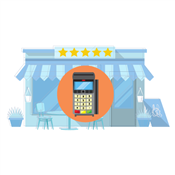
Credit Card Reader

Credit Card Processing Apps

Mobile Credit Card Processing

How to Accept Credit Card on Phone
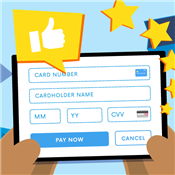
Online Credit Card Processing
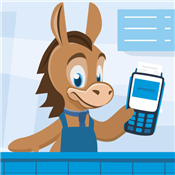
Credit Card Machine
- Flat-rate pricing: all transactions are charged the same flat fee
Square Reader: Free Mobile Credit Card Reader
- Pay 2.6% + 15¢ Per Swipe for Visa, Mastercard, Discover, and American Express
- Accept Credit Cards Anywhere
- Fast Setup, No Commitments
|
|
| ||||||
|
|
|
